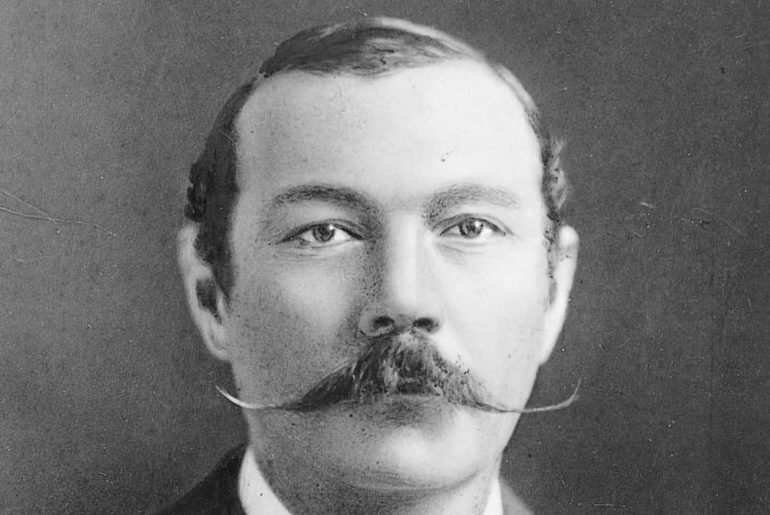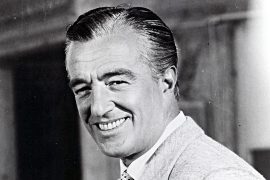Arthur Conan Doyle became famous with the fictional character Sherlock Holmes. He wrote four novels and 56 short stories about the master detective from London – and still had an ambivalent relationship with him.
The path to becoming a doctor and amateur writer
Arthur Ignatius Conan Doyle was born on May 22, 1859 in Edinburgh, Scotland. The boy received little love and attention from his father Charles, a chronic alcoholic.
His mother Mary was different: she was an avid reader of books and an excellent storyteller and passed on to the boy the talent that would make him world famous.
Doyle later said in retrospect that his mother’s storytelling was able to blur the lines between fantasy and reality for him as a child.
At the age of nine, Arthur was sent to boarding school in England. He was very popular with his classmates. He was a great storyteller and was often surrounded by his classmates.
In 1876, at the age of 17, Arthur had graduated from school and returned to Edinburgh, where he ambitiously began studying medicine.
Of the professors, the young student was particularly impressed by Dr. Joseph Bell. This doctor and university lecturer had outstanding powers of observation, an analytical mind and an impressive logic – qualities that later distinguished Doyle’s fictional character Sherlock Holmes.
Doyle tried his hand at writing while he was still a student: his mysterious story “The Mystery of Sasassa Valley”, which was heavily based on the eerie stories of the American writer Edgar Allan Poe, was printed in a local Edinburgh magazine.
When Doyle was also able to sell a second early work, he realized, as he later said, that there were other ways of making money than medicine.
Success came with Holmes
Before Arthur Conan Doyle devoted himself exclusively to writing, he first completed his medical studies and obtained his doctorate.
The adventurous young doctor found his first job on board a ship. During his studies he had already provided medical care to seafarers on a seal catcher. The experiences at sea later flowed into some of his Sherlock Holmes stories.
“Der Schwarzer Peter”, for example, is about a former captain who is brutally killed with a harpoon in his house. A sealskin tobacco pouch leads the master detective on the trail of the killer, a sailor.
Once Arthur Conan Doyle had raised enough money, he resigned from his post as a ship’s doctor, settled on the southern English coast and opened a practice. In 1885 Doyle married his wife Louisa and started a family with her. In addition to his main job as a doctor, Doyle also rediscovered his old passion for writing.
In early 1886 he began work that would change his life – a crime novel about a detective and his helper, a doctor. This story was published in late 1887 in a Christmas magazine, Beeton’s Christmas Annual, entitled “A Study in Scarlet.” Arthur Conan Doyle was paid £25 as a printing fee.
The two main characters in the story are Sherlock Holmes and Dr. watson Doyle had no plans for further episodes with the two. The amateur writer preferred to turn to other subjects and dreamed of gaining recognition as an author of non-fiction with his historical works. But fate meant it differently with him.
By chance, “A Study in Scarlet” fell into the hands of an American publisher. He probably recognized the potential that lay in it and sent a publisher’s representative to Doyle to negotiate with the doctor about a continuation of the detective story. The result was the Sherlock Holmes novel The Sign of the Four, published in 1890.
From 1891 more adventures about Sherlock Holmes followed, which were printed as serial stories with great success in the British “Strand Magazine”. The detective’s crime stories became so popular that the magazine’s sales skyrocketed. Its inventor Arthur Conan Doyle became a rich man thanks to Holmes.
Death and Resurrection of a Roman Hero
Arthur Conan Doyle had grown weary of his character by this point. He therefore planned her literary demise. In The Final Problem, also published in Strand Magazine in 1893, Doyle lets his hero die.
Doyle thought he had rid himself of his character forever. The horror among the many Holmes fans was great. Many people wore black bandages around their arms as a sign of their mourning.
Over 20,000 outraged readers canceled their subscription to “Strand Magazine”. Angry protest letters rained down. Doyle and the publisher were asked to continue the crime stories.
But it was to be a few years before Doyle resurrected the master detective. In the meantime he was politically active and published historical textbooks and non-fiction books. He also invented new heroes and wrote stories that were also published in “Strand Magazine”. They secured his income, but could not build on the popularity of Sherlock Holmes.
In 1900, during the Boer War, which was at stake for English supremacy in the South African colonies, Doyle volunteered for a year in the army and served in a field hospital. His experiences flowed into his book “The Great Boer War” – a 500-page chronicle structured like a textbook for a military academy.
For his services as a military doctor he was knighted by King Edward VII in 1902 and given the title “Sir”. There were rumors that King Edward – like many of his subjects also a big Sherlock Holmes fan – also wanted to give this honor to encourage Doyle to do more Holmes stories. In 1901, the first episode of The Hound of the Baskervilles had appeared in Strand Magazine, but fans thirsted for more.
Convinced by his publisher’s high fee offers, Doyle began, despite all reluctance, to write the Holmes cases as if on an assembly line. A year later, “The Return of Sherlock Holmes” started another series in “Strand Magazine”.
A total of four novels and 56 short stories by the master detective were published, which were translated into over 50 languages and adapted into films, plays and radio plays. His dream of finding recognition as an author of non-fiction books was denied to him.
When Sir Arthur Conan Doyle died on July 7, 1930, he went down in literary history as the father of the world’s most famous and beloved detective character: Sherlock Holmes.
Fascinated by the supernatural
Shortly after his first Holmes story, Doyle wrote “The Mystery Of Cloomber”, a novella in which he addressed the possibility of life after death. The spiritual leanings expressed in this story would become an increasingly important part of Doyle’s life.
Especially after personal strokes of fate, he dealt intensively with the supernatural. Crucial experiences were the death of his first wife Louisa in 1906 and especially the loss of his son Kingsley, who died as a soldier in the First World War.
Doyle made it his mission to explore the unexplored inner life of man. He spent a lot of money on studies in this field. He even became a member of the “Society for Parapsychology”.
His second wife shared this passion for the inexplicable: she was particularly concerned with telepathy and accompanied Doyle on his many journeys in search of the occult.
What is Arthur Conan Doyle known for?
Arthur Conan Doyle, in full Sir Arthur Ignatius Conan Doyle, (born May 22, 1859, Edinburgh, Scotland—died July 7, 1930, Crowborough, Sussex, England), Scottish writer best known for his creation of the detective Sherlock Holmes—one of the most vivid and enduring characters in English fiction.
Why did Arthur Conan Doyle created Sherlock Holmes?
The creation of Sherlock Holmes and his acumen for observation and deduction was said to have been inspired by Doyle’s university professor Joseph Bell whose exacting approach to medicine was well-known.
Is Sherlock Holmes based on Arthur Conan Doyle?
Sherlock Holmes is a fictional character created by the Scottish writer Arthur Conan Doyle. However, Conan Doyle did model Holmes’s methods and mannerisms on those of Dr. Joseph Bell, who had been his professor at the University of Edinburgh Medical School.
How did Conan Doyle revive Sherlock Holmes?
Having tested the waters, Doyle finally resolved to restore Holmes to life with the publication of The Adventure of the Empty House in 1903. Public pressure is often credited with pushing Doyle to revive Holmes.
Who was Sherlock Holmes based on?
Sir Arthur Conan Doyle’s fictional detective with the knack for solving crimes through observation and reason was modeled after Dr. Joseph Bell, one of Conan Doyle’s medical school professors.
Is 221B Baker Street Real?
But 221B Baker street did not exist in 1881, nor did it exist in 1887 when A Study in Scarlet was published and Baker Street house numbers only extended into the 100s. It was a purely fictional address – emphasis on was. Time marches on, Baker Streets are renumbered, and 221Bs are revealed.
What is the IQ of Sherlock Holmes?
Radford estimates Holmes’ IQ at 190, which places him much, much higher than our crazy-haired scientist. Since then, there have been many more studies on this fictional character leading people to lower his intelligence rating, but he still remains one of the smartest characters ever written.
Does Sherlock have autism?
Ultimately, no one representation can ever encapsulate the incredible diversity of the spectrum—and while Holmes is probably an autistic character by most definitions, he is not an autistic person.
What mental illness does Sherlock?
Holmes is unique compared to an average human, but he is not a “high- functioning sociopath.” Holmes most likely suffers from Asperger’s Syndrome, a minor case of Bipolar Disorder, and a hint of Savant Syndrome. Asperger’s Syndrome causes Holmes to think in pictures and desire a close companionship with Dr. Watson.
Is Sherlock a sociopath or psychopath?
Sherlock Holmes is a brilliant but antisocial detective. He doesn’t seem to show emotion or care about other people’s feelings — even those of his trusted sidekick Dr. Watson — and he’s not driven by the fear of offending others. By all appearances, he is a primary psychopath.
What is Sherlock Holmes afraid of?
By now Sherlock has come to understand that the greatest loss, the greatest defeat, what he should – and does – really fear the most is to lose the people he loves.
Who is Sherlock Holmes biggest enemy?
Professor Moriarty, original name in full James Moriarty, archcriminal nemesis of Sherlock Holmes in several detective stories and novels by Sir Arthur Conan Doyle.





